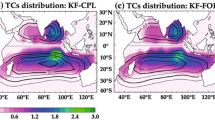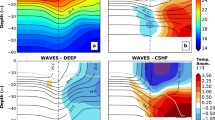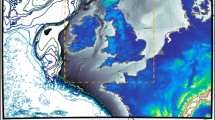Abstract
A coupled ocean–atmosphere–wave model was used to assess the impact of model coupling on the simulations of air–sea fluxes, surface currents, waves, and temperature profile during the passage of a tropical cyclone (TC) Phailin in the Bay of Bengal. Four numerical experiments with different coupling configurations among the atmosphere, ocean, and wave models were carried out to identify differences in simulated atmospheric and oceanic parameters. The simulated track and intensity of Phailin agree well with the observations. The inter-comparison of model experiments with different coupling options highlights the importance of better air–sea fluxes in the coupled model as compared to the uncoupled model towards an improvement in the simulation of TC Phailin. The coupled model configurations overcome the cold bias (up to − 2 °C) in sea surface temperature simulated by the uncoupled ocean model. A higher magnitude of the surface drag coefficient in the uncoupled atmosphere model enhanced the bottom stress (> 2 N m−2). As a result of excess momentum transfer to the sea surface, the uncoupled ocean model produced stronger surface currents as compared to the coupled model. The inclusion of the wave model increases the sea surface roughness and, thereby, improves the wind speed and momentum flux at the air–sea interface. The maximum significant wave height in the coupled model was about 2 m lower than the uncoupled wave model. The model experiments demonstrate that the periodic feedback among the atmosphere, ocean, and wave models leads to a better representation of momentum and heat fluxes that improves the prediction of a tropical cyclone.




















Similar content being viewed by others
References
Bao, J. W., Wilczak, J. M., Choi, J. K., & Kantha, L. H. (2000). Numerical simulations of air–sea interaction under high wind conditions using a coupled model: A study of hurricane development. Monthly Weather Review, 128, 2190–2210.
Bender, M. A., & Ginis, I. (2000). Real-case simulations of hurricane–ocean interaction using a high-resolution coupled model: Effects on hurricane intensity. Monthly Weather Review, 128, 917–946.
Bender, M. A., Ginis, I., & Kurihara, Y. (1993). Numerical simulations of tropical cyclone–ocean interaction with a high-resolution coupled model. Journal of Geophysical Research, 98, 23245–23263. https://doi.org/10.1029/93JD02370.
Bender, M. A., Tuleya, R., Thomas, B., & Marchok, T. (2007). The operational GFDL coupled hurricane–ocean prediction system and a summary of its performance. Monthly Weather Review, 135, 3965–3989.
Booij, N., Ris, R. C., & Holthuijsen, L. H. (1999). A third-generation wave model for coastal regions. Part I: Model description and validation. Journal of Geophysical Research, 104, 7649–7666. https://doi.org/10.1029/98JC02622.
Brand, S. (1971). The effects on tropical cyclone of cooler surface waters due to upwelling and mixing produced by a prior tropical cyclone. Journal of Applied Meteorology, 15, 909–919.
Bright, R. J., **e, L., & Pietrafesa, L. J. (2002). Evidence of the Gulf Stream’s influence on tropical cyclone intensity. Geophysical Research Letters, 29(16), 1801. https://doi.org/10.1029/2002GL014920.
Chan, J. C. L., Duan, Y., & Shay, L. K. (2001). Tropical cyclone intensity change from a simple ocean–atmosphere coupled model. Journal of Atmospheric Science, 58, 154–172.
Charnock, H. (1955). Wind stress on a water surface. Quarterly Journal of the Royal Meteorological Society, 81, 639.
Chaudhuri, D., Sengupta, D., D’Asaro, E., Venkatesan, R., & Ravichandran, M. (2019). Response of the salinity-stratified Bay of Bengal to cyclone Phailin. Journal of Physical Oceanography, 49, 1121–1140. https://doi.org/10.1175/JPO-D-18-0051.1.
Chen, S. S., Price, J. F., Zhao, W., Donelan, M. A., & Walsh, E. J. (2007). The CBLAST-Hurricane program and the next-generation fully coupled atmosphere–wave–ocean models for hurricane research and prediction. Bulletin of the American Meteorological Society, 88, 311–317.
Chen, S. S., Zhao, W., Donelan, M. A., & Tolman, H. L. (2013). Directional wind–wave coupling in fully coupled atmosphere–wave–ocean models: Results from CBLAST-Hurricane. Journal of Atmospheric Science, 70, 3198–3215.
Cione Fort Collins, J. J., & Uhlhorn, E. W. (2003). Sea surface variability in hurricanes: Implications with respect to intensity change. Monthly Weather Review, 131, 1783–1796.
Davis, C. A., Wang, W., Chen, S. S., Chen, Y., Corbosiero, K., DeMaria, M., et al. (2008). Prediction of landfalling hurricanes with the advanced hurricane WRF model. Monthly Weather Review, 136, 1990–2005.
Dudhia, J. (1989). Numerical study of convection observed during the winter monsoon experiment using a mesoscale twodimensional model. Journal of Atmospheric Science, 46, 3077–3107.
Gray, W. M. (1975). Tropical cyclone genesis. Atmospheric Science Paper, 234, 119.
Greeshma, M. M., Srinivas, C. V., Naidu, C. V., Baskaran, R., & Venkatraman, B. (2015). Real-time numerical simulation of tropical cyclone Nilam with WRF: Experiments with different initial conditions, 3D-Var and ocean mixed layer model. Natural Hazards, 77(2), 597–624.
Haidvogel, D. B., Arango, H., Budgell, W. P., Cornuelle, B. D., Curchitser, E., Di Lorenzo, E., et al. (2008). Ocean forecasting in terrain-following coordinates: Formulation and skill assessment of the Regional Ocean Modeling System. Journal of Computational Physics, 227(2008), 3595–3662.
Hong, X., Chang, S. W., Raman, S., Shay, L. K., & Hodur, R. (2000). The interaction between Hurricane Opal (1995) and a warm core ring in the Gulf of Mexico. Monthly Weather Review, 128, 1347–1365.
Hong, S. Y., & Lim, J. O. (2006). The WRF single-moment 6-class microphysics scheme (WSM6). Journal of the Korean Meteorological Society, 42, 129–151.
IMD-Report. (2013). Very severe cyclonic storm, PHAILIN over the Bay of Bengal (08–14 October 2013): A report. India Meteorological Department, Technical Report, October 2013.
Jacob, R., Larson, J., & Ong, E. (2005). M × N communication and parallel interpolation in CCSM using the model coupling toolkit. Argonne: Preprints, Mathematics and Computer Science Division, Argonne National Laboratory.
Jones, P. W. (1999). First- and second-order conservative remap** schemes for grids in spherical coordinates. Monthly Weather Review, 127, 2204–2210. https://doi.org/10.1175/15200493(1999)1272.0.CO;2.
Jyothi, L., & Joseph, S. (2019). Surface and sub-surface ocean response to tropical cyclone Phailin: Role of pre-existing oceanic features. Journal of Geophysical Research: Oceans, 124, 6515–6530. https://doi.org/10.1029/2019JC0152116515.
Kain, J. S., & Fritsch, J. M. (1993). Convective parameterization for mesoscale models: The Kain-Fritcsh scheme. In K. A. Emanuel & D. J. Raymond (Eds.), The representation of cumulus convection in numerical models (p. 246). New York: American Meteor Society.
Komen, G. J., Hasselmann, S., & Hasselmann, K. (1984). On the existence of a fully developed wind-sea spectrum. Journal of Physical Oceanography, 14, 1271–1285. https://doi.org/10.1175/1520-0485(1984)014.
Large, W. G., McWilliams, J. C., & Doney, S. C. (1994). Oceanic vertical mixing: A review and a model with a nonlocal boundary layer parameterization. Reviews of Geophysics, 32, 363–403.
Larson, J., Jacob, R., & Ong, E. (2004). The model coupling toolkit: A new Fortran90 toolkit for building multiphysics parallel coupled models. Argonne: Preprints, Mathematics and Computer Science Division, Argonne National Laboratory.
Lin, I. I., Wu, C. C., Emanuel, K., Lee, I. H., Wu, C. R., & Pun, I. F. (2005). The interaction of Super typhoon Maemi (2003) with a warm ocean eddy. Monthly Weather Review, 133(9), 2635–2649.
Liu, L., Fei, J., Cheng, X., & Huang, X. (2012). Effect of wind–current interaction on ocean response during Typhoon Kaemi (2006). Science China Earth Sciences, 56, 418–433. https://doi.org/10.1007/s11430-012-4548-3.
Liu, B., Liu, H., **e, L., Guan, G., & Zhao, D. (2011). A coupled atmosphere–wave–ocean modeling system: Simulation of the intensity of an idealized tropical cyclone. Monthly Weather Review, 139, 132–152.
Madsen, O. S., Poon, Y. K., & Graber, H. C. (1988). Spectral wave attenuation by bottom friction: Theory. In Proceedings of 21st international conference on coastal engineering, Torremolinos, Spain, Am Soc Civ Eng, pp. 492–504.
Mandal, M., Mohanty, U. C., Sinha, P., & Ali, M. M. (2007). Impact of sea surface temperature in modulating the movement and intensity of tropical cyclones. Natural Hazards, 41, 413–427.
Michalakes, J., J. Dudhia, D. Gill, T. Henderson, J. Klemp, W. Skamarock, & W. Wang. (2005). The Weather Research and Forecast Model: Software architecture and performance. In G. Mozdzynski (Ed.), Proceedings 11th ECMWF Workshop on High Performance Computing in Meteorology, World Scientific, 156–168.
Mohanty, U. C., Niyogi, D., & Potty, K. V. J. (2012). Recent developments in tropical cyclone analysis using observations and high resolution models. Natural Hazards, 63, 1281–1283.
Mohanty, U. C., Osuri, K. K., & Pattanayak, S. (2013). A study on high resolution mesoscale modeling systems for simulation of tropical cyclones over the Bay of Bengal. Mausam, 64, 117–134.
Mohanty, U. C., Osuri, K. K., Tallapragada, V., Marks, F. D., Pattanayak, S., Mohapatra, M., et al. (2015). A great escape from the Bay of Bengal ‘‘Super Sapphire– Phailin’’Tropical Cyclone: A case of improved weather forecast and societal response for disaster mitigation. Earth Interactions, 19, 1–11. https://doi.org/10.1175/EI-D-14-0032.
Mohapatra, M., Bandyopadhyay, B. K., & Nayak, D. P. (2013). Evaluation of operational tropical cyclone intensity forecasts over north Indian Ocean issued by India Meteorological Department. Natural Hazards, 68, 433–451.
Monin, A. S., & Obukhov, A. M. F. (1954). Basic laws of turbulent mixing in the surface layer of the atmosphere. Contribution of Geophysical Institute of the Academy of Sciences of the USSR, 151, e187.
Moon, I. J., Ginis, I., Hara, T., & Thomas, B. (2007). A physics-based parameterization of air–sea momentum flux at high wind speeds and its impact on hurricane intensity predictions. Monthly Weather Review, 135, 28692878. https://doi.org/10.1175/MWR3432.1.
Morel, A., & Antoine, D. (1994). Heating rate within the upper ocean in relation to its bio-optical state. Journal of Physical Oceanography, 24, 1652–1665.
Namias, J. (1973). Birth of hurricane Anges-triggered by the trans-equatorial movement of a mesoscale system into a favourable large-scale environment. Monthly Weather Review, 101, 177–179.
National Geophysical Data Center: 2-minute Gridded Global Relief Data (ETOPO2) v2. National Geophysical Data Center, NOAA (2006). https://doi.org/10.7289/V5J1012Q. Accessed July 2015.
Navaneeth, K. N., Martin, M. V., Jossia Joseph, K., & Venkatesan, R. (2019). Contrasting the upper ocean response to two intense cyclones in the Bay of Bengal. Deep Sea Res Part I, 147, 65–78. https://doi.org/10.1016/j.dsr.2019.03.010.
Neetu, S., Lengaigne, M., Vialard, J., Samson, G., Masson, S., Krishnamohan, K. S., et al. (2019). Premonsoon/postmonsoon Bayof Bengal tropical cyclones intensity: Role of air–sea coupling and large-scale background state. Geophysical Research Letters, 46, 2149–2157. https://doi.org/10.1029/2018GL081132.
Noh, Y., Cheon, W. G., Hong, S.-Y., & Raasch, S. (2003). Improvement of the K-profile model for the planetary boundary layer based on large eddy simulation data. Boundary-Layer Meteorology, 107, 401–427.
Osuri, K. K., Mohanty, U. C., Routray, A., Kulkarni, M. A., & Mohapatra, M. (2012). Sensitivity of physical param-eterization schemes of WRF model for the simulation of Indian seas tropical cyclones. Natural Hazards, 63, 1337–1359. https://doi.org/10.1007/s11069-011-9862-0.
Osuri, K. K., Mohanty, U. C., Routray, A., & Niyogi, D. (2015). Improved prediction of Bay of Bengal Tropical cyclones through assimilation of doppler weather radar observations. Monthly Weather Review. https://doi.org/10.1175/MWR-D-13-00381.1.
Pattanayak, S., Mohanty, U. C., & Osuri, K. K. (2012). Impact of parameterization of physical processes on simulation of track and intensity of tropical cyclone Nargis (2008) with WRF–NMM mode. The World Scientific Journal. https://doi.org/10.1100/2012/671437.
Prakash, K. R., & Pant, V. (2017). Upper oceanic response to tropical cyclone Phailin in the Bay of Bengal using a coupled ocean–atmosphere model. Ocean Dynamics, 67, 51. https://doi.org/10.1007/s10236-016-1020-5.
Price, J. F. (1981). Upper ocean response to a hurricane. Journal of Physical Oceanography, 11, 153–175.
Price, J. F., Sanford, T. B., & Forristall, G. Z. (1994). Forced stage response to a moving hurricane. Journal of Physical Oceanography, 24, 233–260.
Rai, D., Pattnaik, S., Rajesh, P. V., & Hazra, V. (2018). Impact of high resolution sea surface temperature on tropical cyclone characteristics over the Bay of Bengal using model simulations. Meteorological Applications. https://doi.org/10.1002/met.1747.
Rao, R.R., & Sivakumar, R. (2003). Seasonal variability of sea surface salinity and salt budget of the mixed layer of the north Indian Ocean. Journal of Geophysical Research, 108(C1):3009. https://doi.org/10.1029/2001JC000907.
Schade, L. R., & Emanuel, K. A. (1999). The ocean’s effect on the intensity of tropical cyclones: Results from a simple coupled atmosphere–ocean model. Journal of Atmospheric Science, 56, 642–651.
Shay, G., Goni, J., & Black, P. G. (2000). Effects of a warm oceanic feature on Hurricane Opal. Monthly Weather Review, 128, 1366–1383.
Shchepetkin, A. F., & McWilliams, J. C. (2005). The regional ocean modeling system: A split-explicit, free-surface, topography following coordinates ocean model. Ocean Modelling, 9, 347–404.
Skamarock, W. C., Klemp, J. B., Dudhia, J., Gill, D. O., Barker, D. M., Wang, W., & Powers, J. G. (2005). A description of the advanced research WRF version 2. NCAR Technical Note, NCAR/TN-468 + STR.
Srinivas, C. V., Mohan, G. M., Naidu, C. V., Baskaran, R., & Venkatraman, B. (2016). Impact of air–sea coupling on the simulation of tropical cyclones in the North Indian Ocean using a simple 3-D ocean model coupled to ARW. Journal of Geophysical Research: Atmospheres, 121, 9400–9421. https://doi.org/10.1002/2015JD02443.
Sweeney C, Gnanadesikan A, Griffies S, Harrison M, Rosati A, & Samuels B (2005) Impacts of shortwave penetration depth on large-scale ocean circulation heat transport. Journal of Physical Oceanography, 35(6):1103–1119. https://doi.org/10.1175/JPO2740.1.
Taylor, P. K., & Yelland, M. J. (2001). The dependence of sea surface roughness on the height and steepness of the waves. Journal of Physical Oceanography, 31, 572–590.
Wada, A., Cronin, M. F., Sutton, A. J., Kawai, Y., & Ishii, M. (2013). Numerical simulations of oceanic pCO 2 variations and interactions between Typhoon Choiwan (0914) and the ocean. Journal of Geophysical Research: Oceans, 118, 2667–2684. https://doi.org/10.1002/jgrc.20203.
Wada, A., Kohno, N., & Kawai, Y. (2010). Impact of wave–ocean interaction on Typhoon Hai-Tang in 2005. SOLA, 6A, 13–16. https://doi.org/10.2151/sola.6A-004.
Wada, A., Uehara, T., & Ishizaki, S. (2014). Typhoon-induced sea surface cooling during the 2011 and 2012 typhoon seasons: Observational evidence and numerical investigations of the sea surface cooling effect using typhoon simulations. Progress in Earth and Planetary Science, 64, 35623578. https://doi.org/10.1175/JAS4051.1.
Walker, N. D. R., Leben, R., & Balasubramanian, S. (2005). Hurricane-forced upwelling and chlorophyll enhancement within cold-core cyclones in the Gulf of Mexico. Geophysical Research Letters, 32, L18610. https://doi.org/10.1029/2005GL023716.
Wang, Y., & Wu, C. C. (2004). Current understanding of tropical cyclone structure and intensity changes—a review. Meteorology and Atmospheric Physics, 87, 257–278.
Warner, J. C., Armstrong, B., He, R., & Zambon, J. B. (2010). Development of a coupled ocean atmosphere–wave–sediment transport (COAWST) modeling system. Ocean Modelling, 35, 230244. https://doi.org/10.1016/j.oceanmod.2010.07.010.
Willmott, C. (1981). On the validation of models. Physical Geography, 2, 184–194.
Acknowledgements
Ocean observation programme of the National Institute of Ocean Technology (NIOT), Chennai, is gratefully acknowledged for the deployment and maintenance of OMNI buoy. OMNI buoy BD09 and BD10 data was acquired from Indian National Centre for Ocean Information Services (INCOIS), Hyderabad. ECCO2 (https://www.esrl.noaa.gov/psd/.) is a contribution to the NASA Modeling, Analysis, and Prediction (MAP) program. The authors acknowledge the funding supports from Space Applications Centre, ISRO and Ministry of Earth Sciences (MoES), Govt. of India. KRP acknowledges UGC-CSIR for his PhD fellowship support. The High Performance Computing (HPC) facility provided by IIT Delhi and supported by Department of Science and Technology (DST-FIST, 2014), Govt. of India are thankfully acknowledged. The model data used in this publication is available on request from the corresponding author. Graphics generated in this manuscript using Ferret and NCL.
Author information
Authors and Affiliations
Corresponding author
Additional information
Publisher's Note
Springer Nature remains neutral with regard to jurisdictional claims in published maps and institutional affiliations.
Rights and permissions
About this article
Cite this article
Pant, V., Prakash, K.R. Response of Air–Sea Fluxes and Oceanic Features to the Coupling of Ocean–Atmosphere–Wave During the Passage of a Tropical Cyclone. Pure Appl. Geophys. 177, 3999–4023 (2020). https://doi.org/10.1007/s00024-020-02441-z
Received:
Revised:
Accepted:
Published:
Issue Date:
DOI: https://doi.org/10.1007/s00024-020-02441-z




